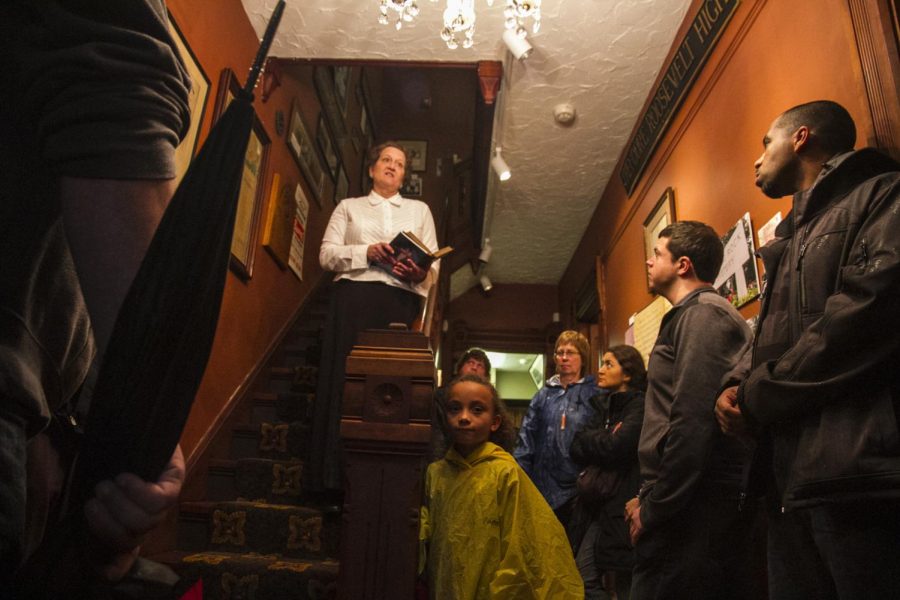Ghost Walk unveils Kent’s past
October 25, 2015
On a cliché, dark and stormy Saturday night, a group of international scholars and students took part in the annual Downtown Kent Ghost Walk at the Kent Stage to hear Kent’s spookiest ghost stories.
The ghost tour invited both locals and visitors to learn about the city’s history, beginning in the mid-1800s to modern day, and the legends and stories that connect them together.
Scholars and students from the Gerald H. Read Center for International and Intercultural Education, who came to Kent State to learn about America said they were excited to share in America’s festival of the dead: Halloween.
Ghost stories around the world:
This is what the international scholars who took the tour shared as the equivalent of ghosts in their native lands.
China: Ancestors
Because of China’s censorship laws against superstitions, not much is said of actual ghosts, but the scholars said they do celebrate their ancestors, who are believed to be immortal.
Turkey: Melek & Cin
There are two ghosts in Turkish culture: Mekel, meaning “angel,” which are harmless, good spirits, and Cin, derived from the Arabic “djinn,” which are evil spirits causing misfortune for anyone who says the name.
Saudi Arabia: Djinns
Better known as “genies” in America, these mythical creatures are powerful beings made of smokeless fire and created by Allah. Their invisibility makes them ghost-like, and they are said to be able to possess humans. They can be good, evil or neutral.
Didem Kepir-Savoly, a professor from Hacettepe University in Turkey, has been in America for three weeks and said she has always looked forward to Halloween.
“It’s pretty fun for me because I was always interested for this festival from the movies, and I’ve always wanted to be a part of it,” she said. “It’s a reason for people to go out and drink, but this first event is really good because we can be a part of this spiritual thing.”
Kepir-Savoly said her culture’s relationship with ghosts is completely different: ghosts are hardly ever mentioned.
Kepir-Savoly said there are two kinds of ghosts in Turkey: Melek, who are harmless, and Cin, who are bad ghosts. She said the Cin are so feared that many don’t even say the name and just refer to them as “those-three-letters.” It is believed if the name is mentioned, it invites the Cin to approach people and cause misfortune in their lives.
Kepir-Savoly said because of her culture, she is probably more afraid of ghosts than most Americans, who she said are brave to talk so openly about ghosts and superstitions.
The Ghost Walk
The tour began at the Kent Stage, known for entertaining Kent residents for decades, but where many believe lively spirits reside.
The group visited a supposed haunted house on 131 Columbus St., built in the 1860s by a man for his wife (he went bankrupt building it and never got to live in it.) After a while, it was repurposed as a hospital, then a home. Legend has it the guest room has always been a spot where strange phenomena occur late at night.
The guides brought them to the Empire State of Thought, where visitors can receive tarot readings, crystals and incense.
Samantha Wilmoth, a medium who lends her services to the shop regularly, gave the tourists words of wisdom and said to open their eyes to things they cannot explain or understand.
She spoke about the origins of her gift of spirituality after witnessing the apparition of her dying grandfather just moments after her family got a call that he had passed. As they began to leave, Wilmoth gave the tour one last piece of advice: Keep your eyes — and your mind — open.
The next stop was the Franklin Avenue Gazebo, where the group heard the tale of a man who died on the train tracks next to the gazebo. But, when death came calling like a train whistle, he didn’t get his ticket to the great beyond, and his restless soul carries on.
Afterward, the group was taken to the Secret Cellar in Acorn Alley, a self-proclaimed speakeasy with the right kind of spirits.
The tour then traveled to the Kent Historical Society, where it heard a tale of another tortured spirit documented in a 1980s edition of The Daily Kent Stater.
Kasha Legeza, dressed in Victorian garb, told the last ghost story of the night about the family who founded Kent. The house the group found itself in was decked with the knickknacks and possessions of a time forgotten, perhaps even inviting the souls to stay in a home with no negative energy, Legeza said.
Steven Antalvari, director of university advising, also came with the scholars and said he enjoyed the tour. He said he’s met many international scholars and students who look forward to traditions like pumpkin-carving and haunted houses. He also said this was an excellent opportunity to expose international visitors to American ghost stories and traditions of Halloween, which can have similarities to those in other countries.
“I can only speak from a small handful of western European countries, but all the countries that I’ve been to have their paranormal stories, their mysticism. The different things that kind of guide their culture,” he said. “We certainly don’t over-sensationalize it, but we definitely add our American flare to it.”
Bruce Walton is a senior reporter for The Kent Stater. Contact him at [email protected].

























